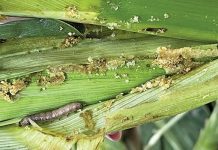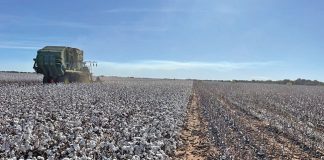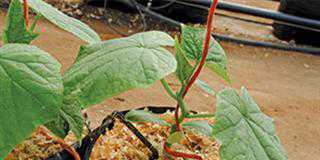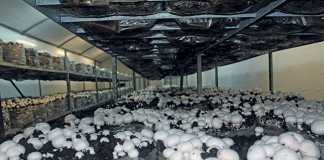A few bold, forward-thinking crop farmers in the North West are proving that no-till works in the province. Amongst them is Hannes Otto of Ottosdal who has practised conservation agriculture (CA) for the past four years on his farm Korannafontein.
Implementing CA practices can reduce input costs considerably, but Hannes’s decision to adopt CA was motivated more by his desire to reverse the ravages of decades of conventional tillage on his soil, as he realised there would otherwise be little left for future generations to inherit. In 2007, he had his soils analysed, mapped and balanced, and planned how to adopt and practise all three CA principles.
Minimum soil disturbance
Hannes still grows crops on the same 2 200ha, but he now rotates them. He plants about two-thirds of his arable land no-till to Roundup Ready maize for two years, with the other one-third alternatively planted no-till to Roundup Ready soya beans or sunflower. In the third year he rotates them. Row width has changed from 2,23m to 91cm and plant populations from 16 000/ha to 18 000/ha for maize, and from between 30 000/ha and 35 000/ha to 40 000/ha for sunflower.
The newly introduced soya bean crop is planted no-till at 350 000 plants/ha. While Hannes expected his yields to drop in the first three years of CA, he says the opposite happened. “This past season has seen my maize crop increase to an average of 5,5t/ha from 4,8t/ha, and my sunflower to 2,3t/ha from 1,8t/ha when I started CA,” he says. “This is in sharp contrast to the 3,6t/ ha maize and 1t/ha sunflower I harvested in the 1995/6 season, and my 11-year average of 4,1t/ha for maize and 1,8t/ha for sunflower during the 1996 to 2006 period.”
Residue retention and cover crops
Hannes sets his combine harvester trash spreader to spread the crop residue evenly and form a mulch to protect the soil, retain moisture and be gradually incorporated into the soil to increase its organic matter content. Combine headers, set at a height of about 25cm, cut maize stalks to form a barrier to prevent residue from blowing away in windy conditions and to impede runoff after a heavy downpour to allow better infiltration.
“I planted about 100ha of forage sorghum no-till as a cover crop on my fallow lands in October/November in my first year of adopting CA,” explains Hannes. “Then I sprayed it with glyphosate in March, and then flattened it with a knife roller to form a mulch to protect the soil from water and wind erosion and moderate temperature fluctuations, and to absorb and retain moisture from late rain in March and April for the maize crop planted in November.”
While the forage sorghum fulfilled all these requirements, Hannes planted cowpeas no-till as a cover crop in the second year using the same practice. He found that cowpeas’ nitrogen-fixing properties increased the yield of the following maize crop by about 1t/ha.
So he decided to plant cowpeas no-till as the cover crop of choice on fallow lands, and to increase the hectarage left fallow in light of the current maize surplus and the expected carry-over stocks. But if the soya beans he planted for the first time this year do well, he will consider planting less fallow land to cowpeas and more to soya beans as the latter has the same beneficial nitrogen-fixing properties as cowpeas, but also produces a cash crop.
To conserve soil moisture, farmers in the area often leave a portion of their lands fallow, keeping them weed-free from harvesting to planting by either repetitive mechanised or herbicide means. The former leaves a loose soil surface subject to water and wind erosion, and the latter a crust that doesn’t easily absorb rainfall and is subject to sheet erosion.
“But a cowpea cover crop gives all the soil enhancement, protection and moisture-retention benefits, plus an increase in yield in the subsequent maize crop,” he explains. “It’s also far more economical than leaving the soil bare. Instead of repetitive mechanical or herbicide weed control in the fallow period, we only have to spray herbicide pre- and post-emergence and plant the cover crop.”
Multicropping and crop rotation
The district’s maize crop in the past season generally suffered from diplodia, which Hannes attributes to the common practice of monoculture. This resulted in much of the maize being downgraded to grade 2 or 3. On the lands where he had planted maize two or three years running, he had the same problem. But maize grown in rotation was free from this disease, convincing him that crop rotation minimises disease transmission.
His first crop rotation experiment was with cowpeas, which worked quite well. He then trialled sunflower. But while well-adapted to the area, this crop suffered a serious weed problem that he tried to control by herbicide as opposed to mechanical means. One year, he didn’t spray winter weeds in a few lands early enough to eradicate them. Inter-row spraying was also a problem in sunflower, solved by fitting home-made deflector plates to the spray rig to protect the plants from the herbicide.
Now Hannes sprays glyphosate from early winter until the pre-emergence stage to keep the lands weed-free. Metgan Gold applied at planting is followed five weeks later by a Gramoxone application. Spraying completely controls the weed problem, and Hannes now considers sunflower as economically equal to maize.
“We planted Roundup Ready soya beans for the first time with some trepidation this past season as part of our multicrop rotation plan. It’s not a crop planted in this area, but we were pleasantly surprised at the yield of 2,6t/ha and we plan to continue using it in our rotation cycle,” he says. “From my experience, multicropping and crop rotation are crucial factors in CA.”
To cope with the growth of CA from 25% to 100% of his arable land over the last four years, Hannes has bought three new eight-row no-till planters, bringing the total to four. He has one new 148kW 4×4 tractor, two 120kW tractors and one new self-propelled 183kW sprayer with a 30m boom and all necessary accessories. “Any crop farmer adopting no-till must invest in first-class no-till planters and sprayers, as these are key to success.
“Adopting CA has markedly reduced soil and wind erosion. We see this in the clear and greatly reduced runoff after a heavy downpour, and there’s far less dust billowing up to envelop the operators when planting. The sandy soils have also become more friable, indicating enhanced soil structure. “Microbial life is returning and the soil retains more moisture. I haven’t yet seen any earthworms, but I expect them to return as the benefits of my holistic CA practices are realised.
The improvements are truly mind-boggling. “Against this background, and with South African crop farmers’ tenuous position due to low grain prices and escalating input cost, I believe they should seriously consider CA practices – it’s the only way to go!”













